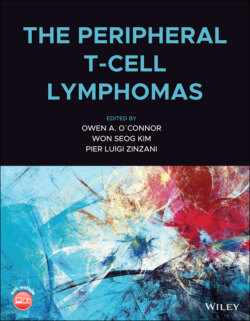Читать книгу The Peripheral T-Cell Lymphomas - Группа авторов - Страница 102
Large Granular Lymphocytic Leukemia
ОглавлениеLarge granular lymphocytic leukemia (LGLL) constitutes around 6% of the chronic lymphoproliferative disorders in Asia and approximately 2–5% of the chronic lymphoproliferative disorders in the United States [54]. The incidence of LGLL is 0.2 cases per 1 000 000 individuals (range 0.17–0.23). The incidence among African Americans, American Indians/Alaska Natives or Asian/Pacific Islanders is not significantly different compared with White Americans [69]. LGLL is rare in children, and exhibits a median age of onset of 60 years [70]. There is no reported gender difference in incidence.
A distinctive feature of LGLL is its known association with autoimmune and hematological disorders. Rheumatoid arthritis is the most common autoimmune disorder which is known to be associated, occurring in approximately 25% of patients with LGLL [71]. It is also known to coexist with other myeloid and lymphoid malignancies, including monoclonal gammopathy of undetermined significance, follicular lymphoma, Hodgkin lymphoma, chronic lymphocytic leukemia, mantle cell lymphoma, and hairy cell leukemia [72, 73].
